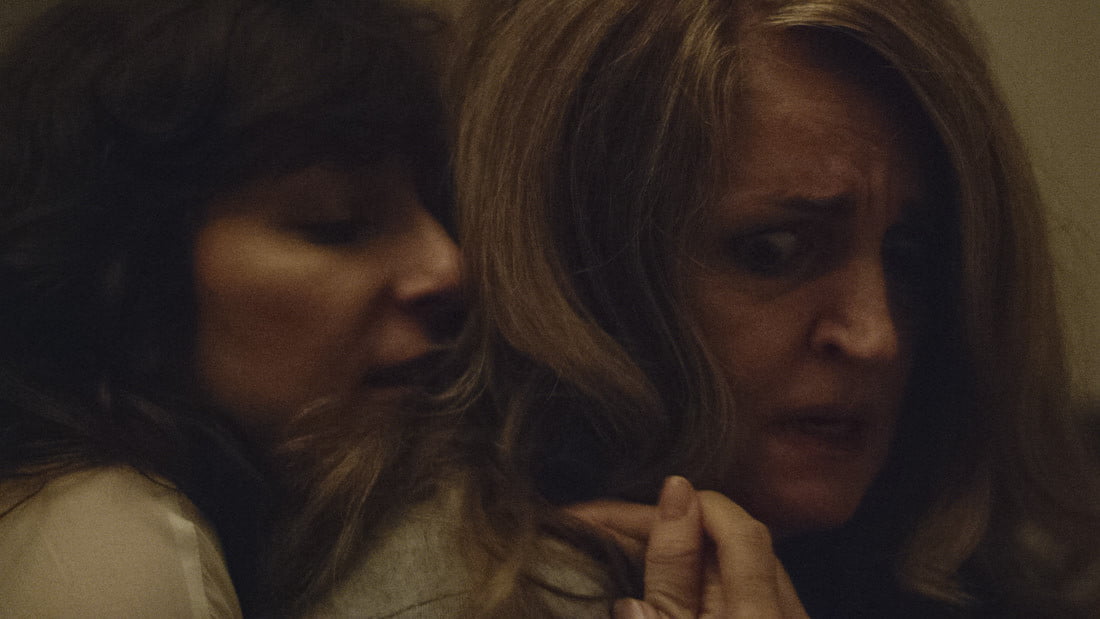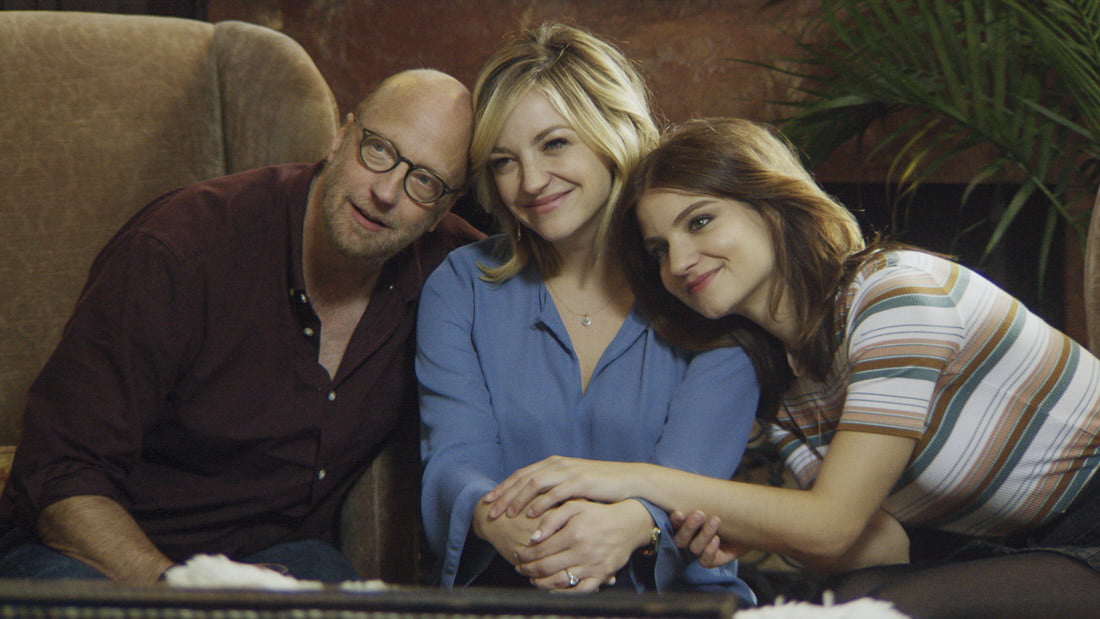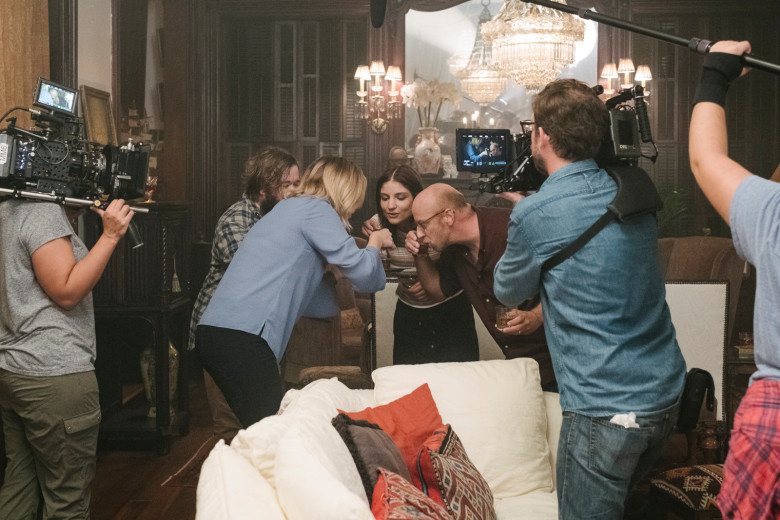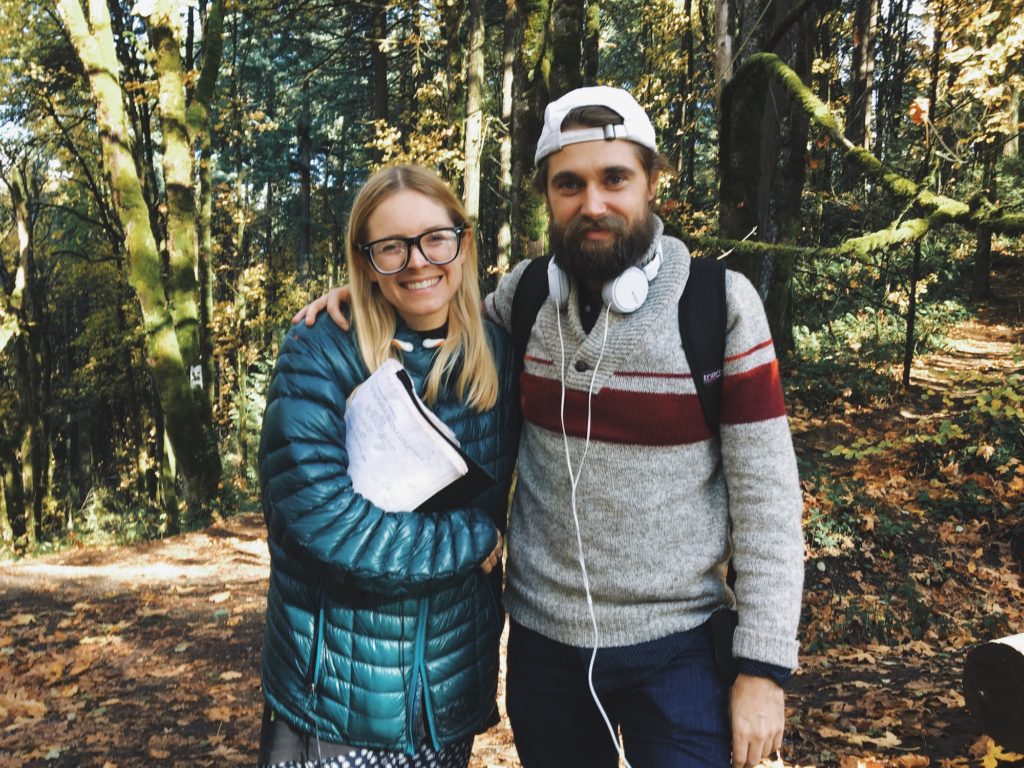BRIDEY ELLIOTT comes from what is usually referred to as a “showbiz family,” with branches of her family tree working in the entertainment industry dating back to the 1940s. There was radio hosting and early TV acting for her late grandfather Bob Elliott (Bob and Ray); comedy writing and acting for her father Chris Elliott (Cabin Boy, There’s Something About Mary, Schitt’s Creek); casting and production for her mother Paula Niedert Elliott (Late Night with David Letterman); and acting for older sister Abby Elliott (Saturday Night Live, Life Partners, Odd Mom Out). Bridey herself followed the acting route (Fort Tilden, Battle of the Sexes, Silicon Valley), but has also pursued a path as a filmmaker. And when you have one of those showbiz families, why not put them to use? Bridey wrote a screenplay for her mother, father, and sister to co-star in, CLARA’S GHOST, which also marked Bridey’s feature debut as a director.
Clara’s Ghost premiered at the 2018 Sundance Film Festival. In the film, Clara Reynolds (Paula) feels ignored and unappreciated by her narcissistic family of actors (played by Chris, Abby, and Bridey). That isolation has manifested itself into visions of a dead woman (Isidora Goreshter) wandering their rural New England property. That supernatural guidance seems to grow over the course of one boozy night at their historic house with the family, their landscaper/weed dealer (Haley Joel Osment), and Clara’s ghost. The film is now out in select theaters and VOD/Digital HD, courtesy of Orion Classics.
We got to chat with writer/director/actor Bridey Elliott about what it was like making a movie with her family, in their family home, on a tight budget and an even tighter schedule.
——
COLIN McCORMACK: How did you come up with the initial conception for the script?
BRIDEY ELLIOTT: I had written a pilot for my father and me to act in together; it was based on Tatum O’Neal and Ryan O’Neal’s estranged relationship. I really got interested in how show business affected families and family dynasties. Then my parents were actually thinking about selling their house and I was like, “Oh no, this house is so cool! I really wanted to shoot something here someday.” Those two ideas kind of collided for me when I came home for the holidays. Like, Oh okay, we could set a Long Day’s Journey Into Night story in this house and everyone can act in it; my sister and my mom and my dad. I just had this instinct that working with all of them together would work.
CM: Did the threat of them selling the house help you in terms of productivity or finishing the script maybe quicker than you would have? Or are you pretty good at setting deadlines for yourself?
BE: I wouldn’t say I’m good at deadlines [laughs]. But yeah, I do think that the threat of it maybe not being there forever helped me move really fast. I wrote this really fast; not really under-the-gun in any sort of way, but there was this element where I was like, It’s set over the course of a single night and I feel like I know where that night can go. It took me like two years to actually get the finished script, but in outlining it I really was inspired by the times I’ve had with my family in recent years and [my parents] being empty-nesters and my sister and I not having kids of our own. Sometimes when there’s a kid around or a baby there’s kind of a distraction from old family dynamics, but we don’t have that yet so it’s just two adult children and their parents hashing it out sometimes. I think I was inspired by the way our relationship transformed, and all kinds of family dynamics, and how they can inhibit you unless you become conscious of them.
CM: How early did your family members read the script? Were they giving feedback along the way, either about their characters or the script as a whole?
BE: My father read the first draft just because I wasn’t sure if this was anything anyone wanted to do, including him. I always send him my stuff for feedback. And he was into it. He gave me the greenlight in a way of, “Let’s keep working on this, I love this idea.” The parts were kind of there from the get-go. Then my sister and my mom read it later on and we all had a table read. I’d say the first table read with everyone was about six months out from production and it was surreal because we were in our house reading it and it just felt like a night spent with our family. There was this little [feeling] like, Oh we’re doing something pretty vulnerable here. But I think we were all excited by that at the same time.

CM: Speaking of vulnerability, was it difficult to convince your mom to take on such a juicy role since she’s the only one of the family who’s not a professional actor?
BE: She said yes because – and she’s been saying this – she didn’t really think it was going to happen [laughs]. Which, you know, a lot of creative projects fall by the wayside. I know I have a million ideas I want to do and then one of them happens maybe. So she said yes right away because she’s my mom and she’s polite. But then I think as we got closer it became more and more real for her and she was definitely very nervous, but the nerves I feel helped her get into this character. She also trained with my acting coach in New York and she did prep. We did rehearsal; it was very little and minimal for a very small indie movie that was chaos leading up to it, but she did prep and felt comfortable enough. A few days in, the schedule was so hectic that everyone was just like, “Oh yeah, we just gotta do this.” So there really wasn’t any room for second-guessing or questioning. It was about just going with it.
CM: What was your shooting schedule?
BE: We shot for 17 days in Connecticut. We shot on the weekends and it was really intense. Long days. Very long days. We wrapped at like 7:30 a.m. one morning and it was very fun and crazy. There was a summer camp kind of vibe because we were all doing this, no one was really getting paid, we didn’t have that much money, we all were living together – the cast and crew – in a rental house by a lake. There was this quality of just getting up and going and being really rigorous about it all.
CM: Were your parents staying at the house in between shooting days?
BE: No, thank God. They thought they were going to be able to actually stay at the house while we were shooting the whole time. They thought, “Oh yeah, they’ll be downstairs. We can just watch HGTV in our room!” But no, they were in a hotel. They got their own space, thank God. Because that was one thing we definitely all needed; we needed some separation from the house itself. Right now they are selling it, so it’s like this movie sort of sealed the deal on our love for the house.
CM: It’s such a beautiful house. Did you guys have to do a lot of art direction or production design for it or is a lot of the look how it is in real life?
BE: A lot of the look is how it is. My family has always set-dressed their homes as if they were movie sets. I’ve always felt that way, like, I feel like we live in a haunted house. So I’ve always been inspired by some of the antiques. Like there was a puppet that’s in the movie and different kinds of sculptures that truly haunted my dreams since I was little. It was fun to utilize them and put them in the movie. But there was very little set dressing. We did have a wonderful production designer that almost toned it down and made the home feel a little bit more hip than it is, I’d say. But it all was there.
CM: In terms of the shooting schedule and the order of the scenes, how did you coordinate shooting the calmer scenes versus the more debaucherous parts of the evening?
BE: We had this whole dream of, We’re going to save my mom’s larger scenes toward the end to get her comfortable. And all the dream ideas went out the window because of time. It was a very mismatched [process] of, We’re going to do drunken chaos now, and then later on we’re going to do this early scene, and then Mom has to make out with Haley at like four in the morning. It was a very strange low-budget thing. We worked with a lot of people, strategically, that were doing this for the first time. This was my first feature, my producers’ first feature. We were all pretty much doing an experiment and finding it as we went. Schedule-wise, yeah, it was a mess [laughs]. There wasn’t a method to the madness, it was more, “Let’s get it!” We had 17 days, not a lot of time.
CM: Were you shooting with multiple cameras?
BE: We had two cameras, yeah.
CM: Was that because of the potential for ad-libbing? To be able to catch everything?
BE: There was that aspect, and it was sort of necessary for everything, to get B-roll at certain times, grab certain things. For sure there are bigger scenes where we’re ad-libbing or we’re dancing around the living room where I just wanted to make sure that everything was caught. I wanted this to be an actors’ movie where actors can go crazy and own the movie. And I think that did happen. The actors own this movie and the camera really is following these people in their house. You can tell there’s a free rein vibe to it because we were immediately comfortable there.
CM: You, as an actor and director, do you have to get yourself into a different headspace when you are going in front of the camera? Or on a low-budget production like this, is there no time to be that precious about it?
BE: There was no real time. There was a scene early on in filming where I was like, “Oh man, I wish I could be improvising with my family right now. Everyone’s being super funny and I’m thinking about three things that are glaring in my head about how this should be looking.” But yeah, there were definitely times where I shut it off and I found my footing with that a little bit. Like at first it was a little bit muddy and I was thinking about time and I was thinking about where the camera is and where we need to be angled and placed and everything. But this was me observing. This whole script was kind of an observation on family dynamics, I would say, and regressing to those family roles that we’re born into. To me, there was this interesting thing where my character is sort of doing that. She’s quietly observing, so everything played together.
CM: In terms of the post-production process, did you have a pretty quick turnaround time from when you wrapped to when you had to start doing festival submissions?
BE: Yeah, we had an insane turnaround. We had three weeks to submit to Sundance, so we edited like maniacs. Then I was sick for three months with a mysterious illness. Truly, I think I was just overworked and had never really recovered from shooting and then going into the editing room. So we had three weeks and then we had two weeks before we knew if we got in or not, and that was the only time where we took a little breath with it. Then it was, You’re in! And it was like, “Oh shit, we have to finish now!” It was a crazy, crazy process… It was only after Sundance that we could actually relax and take a breath and go in and do more tweaking. But at that point, we had worked so hard on getting it to a good place that there wasn’t much to do in terms of tweaks and edits. We got a lot done in that first three to six weeks.
CM: So now that it’s come out, what’s next for you?
BE: I’m writing a second feature now. I’ve been directing more this year. I directed TV and some commercials and now I’m just in the headspace of writing a second feature, which is a larger movie. It’s not something I can just go home and do [laughs]. So I’m taking my time with it and trying to get the strategy right for how to go about it.

__
Thanks to Bridey for talking to us about CLARA’S GHOST.
This interview has been edited for clarity.
If you’re an independent filmmaker or know of an independent film-related topic we should write about, email blogadmin@sagindie.org for consideration.



